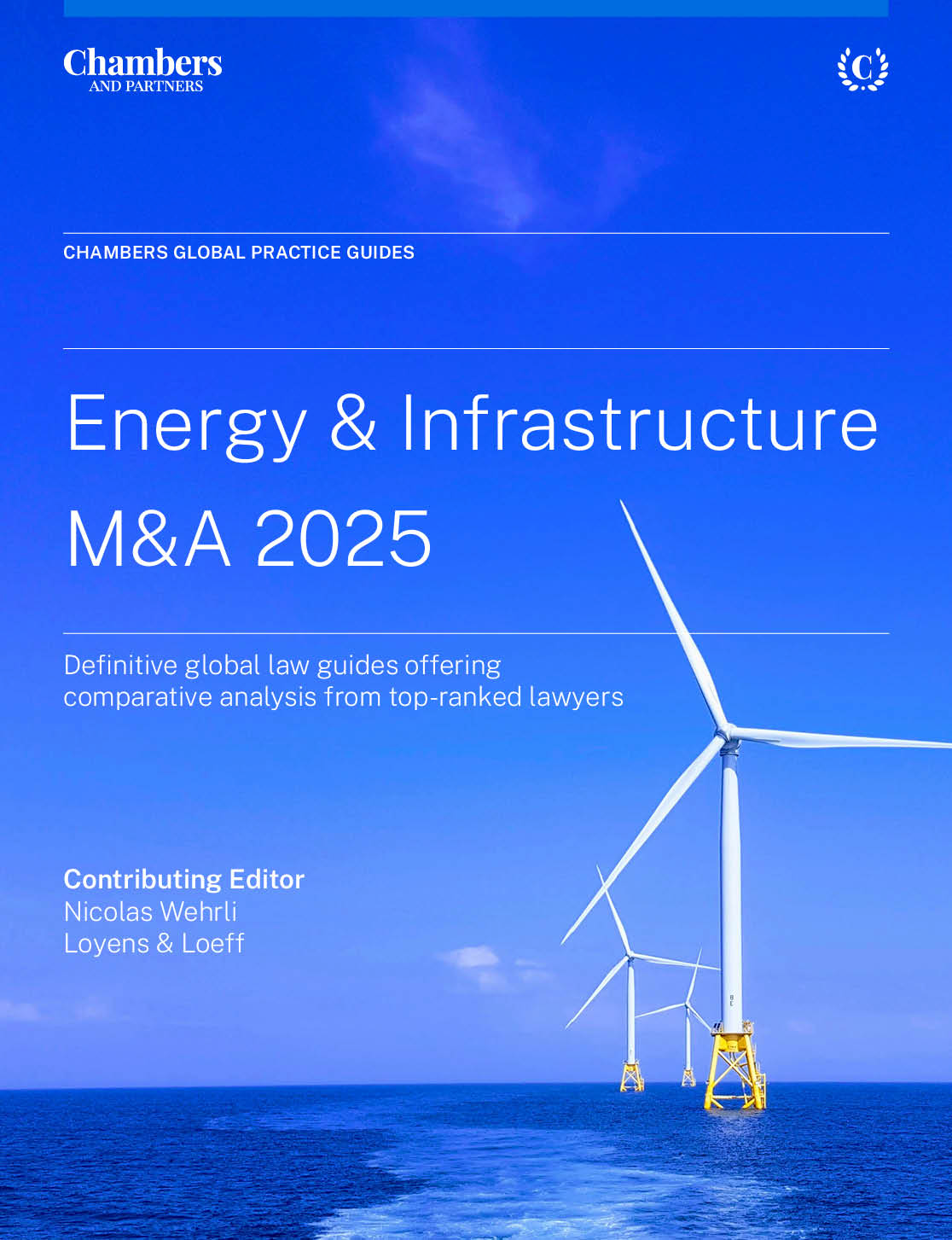
Energy & Infrastructure M&A 2025
The Energy & Infrastructure M&A 2025 guide features 25 jurisdictions. The guide provides the latest legal information on trends in energy and infrastructure M&A markets around the world; procedures for establishing, acquiring and selling energy and infrastructure companies; and regulatory requirements affecting transactions in the sector, including labour rights issues, foreign investment restrictions, disclosure, due diligence and directors’ duties.
Last Updated: November 19, 2025
Compare law and practice by selecting locations and topic(s)
Select Locations

Select Topic(s)

Please select at least one location and one topic to use the compare functionality.
Despite entering 2025 with considerable optimism, the year has presented notable challenges for energy and infrastructure M&A. While the broader global M&A market has shown mixed signals, with some regions and sectors experiencing a rebound in deal value, but overall deal volume remaining subdued, the energy and infrastructure sectors have faced headwinds. Regulatory uncertainty, inflationary pressures, and ongoing supply chain disruptions have weighed on transaction activity, resulting in deal volume and value that have not fully met initial expectations.
Nevertheless, there are several reasons to be optimistic about the outlook for energy and infrastructure M&A in the coming year. The continued drive for decarbonisation, the imperative of energy security, and the rapid pace of digital transformation are all expected to support renewed deal activity. Portfolio realignment, the availability of capital, advances in technology, and the emergence of innovative deal structures are likely to underpin M&A, even as market participants navigate a complex macroeconomic and regulatory environment. As companies and investors adapt to evolving policy frameworks and rising ESG expectations, the sector is well positioned to capitalise on emerging opportunities and play a pivotal role in shaping the future of global energy and infrastructure.
Global Trends in Energy and Infrastructure M&A
The global energy and infrastructure sectors are experiencing profound transformation, driven by technological innovation, the acceleration of the energy transition, regulatory changes, and shifting investor priorities. M&A remains central to this evolution as companies optimise portfolios, scale up renewable investments, and respond to new challenges.
Energy transition and renewables
The global push toward decarbonisation and net-zero targets continues to be the primary catalyst for M&A. Governments and corporates are investing heavily in renewables, ie, wind, solar, hydrogen, and energy storage. In 2024, renewable energy M&A activity reached new highs, with deal value and volume up 12% to approximately USD3.4 trillion globally, and energy transition M&A accounting for USD497 billion (about 13.4% of global M&A activity). Major oil and gas companies are further diversifying into renewables, while utilities expand their clean energy portfolios to meet regulatory and investor expectations. Notably, AI-driven electricity demand (especially from data centres) is accelerating investment in renewables, storage, and grid upgrades, making digitalisation a key trend.
Energy storage and grid modernisation
The integration of intermittent renewables has intensified demand for advanced energy storage and grid modernisation. M&A in battery storage, smart grids, and digital infrastructure surged in 2024, as companies sought technologies to enhance grid stability and support electrification. The rise of AI-driven electricity demand, particularly from data centres, is accelerating investment in these areas. Grid digitalisation, including smart meters, demand response, and AI-based grid management, is now a top priority for utilities and investors.
Oil and gas consolidation
Despite the energy transition, consolidation in oil and gas persists, driven by high commodity prices, geopolitical uncertainty, and the need for scale. Companies are focusing on natural gas, carbon capture, and low-carbon alternatives, with several landmark deals announced in 2024. US oil and LNG production is forecast to rise through 2026, even as renewables gain market share. Oil and gas companies are also investing in adjacent sectors such as hydrogen, biofuels, and carbon capture, reflecting a broader energy transition strategy.
Private equity and infrastructure
Private equity continues to play a vital role in infrastructure, with strong interest in digital infrastructure, energy transition assets, and sustainable transport. Institutional investors are increasing allocations to infrastructure, seeking inflation-hedged, long-term returns. Significant “dry powder” remains available for deployment, supporting robust deal activity. Private equity funds are particularly active in digital infrastructure and are forming partnerships with strategic investors to access large-scale opportunities.
Digital infrastructure
Digital infrastructure has emerged as a major M&A hotspot, driven by the explosive growth of data, cloud computing, and AI. Investments in data centres, fibre networks, and edge computing are accelerating, with both strategic and financial investors seeking to capitalise on the digital transformation of economies.
Regional highlights
Regional dynamics continue to shape the energy and infrastructure M&A landscape in distinct ways. In the United States, recent policy shifts are expected to favour traditional energy sources; however, bipartisan support for renewables, particularly solar and storage, remains strong, ensuring continued investment in clean energy. Across Europe, the focus is on energy security, the expansion of renewables, and grid upgrades. Nevertheless, high costs and regulatory complexity may temper the pace and volume of deal activity in the region. Meanwhile, Asia and emerging markets are experiencing robust growth in renewables, critical minerals, and infrastructure, with China, India, and Latin America standing out as key areas of expansion. These regions are also seeing an increase in cross-border transactions and public–private partnerships, further accelerating infrastructure development and investment opportunities. These regional dynamics are reflected in both the volume and nature of M&A transactions across markets.
Key Challenges Facing Energy and Infrastructure M&A
Regulatory and policy uncertainty
Policy shifts, such as updates to the EU Green Deal, the US Inflation Reduction Act, and new Asian regulations, continue to create both opportunities and risks for dealmakers. Geopolitical tensions, resource nationalism, and protectionist measures add further complexity to cross-border transactions. For example, recent tightening of foreign direct investment (FDI) screening in Europe and expanded Committee on Foreign Investment in the US (CFIUS) reviews have led to longer deal timelines and, in some cases, deal abandonment.
Diverging regional policies and increased scrutiny of foreign investments, especially in critical infrastructure, require careful navigation and robust due diligence.
Supply chain and inflation pressures
Persistent supply chain disruptions and inflationary pressures continue to impact project costs and deal valuations. Higher interest rates have moderated deal sizes and increased selectivity, but recent rate cuts are supporting renewed activity. Companies are adapting by seeking resilient supply chains, localising procurement, and exploring strategic partnerships with suppliers.
Construction delays, rising material costs, and labour shortages remain significant hurdles for both acquirers and targets. In response, dealmakers are increasingly using innovative financing structures, such as earn-outs or contingent payments, to bridge valuation gaps and manage risk.
Sustainability and ESG considerations
ESG considerations remain central to M&A strategy. Investors prioritise assets with strong ESG credentials, and regulatory scrutiny of sustainability claims increased in the last year. ESG due diligence now routinely covers not only environmental but also social and governance risks, with buyers seeking greater transparency and accountability. Concerns about “greenwashing” are prompting more rigorous verification and disclosure requirements. Some investors are recalibrating ambitions, with a renewed focus on core infrastructure and profitability. The increasing importance of social and governance factors is also shaping deal criteria and post-transaction integration.
The challenge of balancing ESG goals with financial returns is growing, especially as regulatory requirements for disclosure and reporting become more stringent.
Outlook for 2026
As we look ahead to 2026, the global energy and infrastructure M&A landscape is expected to remain dynamic and resilient. Electrification, energy security, and digital infrastructure will continue to drive strategic M&A, while regional policy divergence and ongoing geopolitical tensions will create both challenges and opportunities.
Investment in renewables, storage, and grid modernisation will remain strong, supported by AI-driven electricity demand and net-zero commitments. Hydrogen and critical minerals (such as lithium and copper) are emerging as new frontiers for M&A, with growing interest from both strategic and financial investors. At the same time, consolidation in oil and gas will persist as companies seek scale and capital discipline, and US oil and LNG production is forecast to rise through 2026. Strategic investments in carbon capture, hydrogen, and biofuels are also expected to increase.
Private equity and institutional investors will continue to deploy significant capital, especially in digital and core infrastructure, as fundraising rebounds and “dry powder” remains high. Partnerships between private equity and strategic investors are likely to become more common, particularly in large-scale digital infrastructure projects such as data centres and fibre networks.
Looking ahead, several developments are expected to shape the market in 2026. The acceleration of AI-driven energy demand, especially from data centres, will have a significant impact on grid investment and modernisation priorities. Growth in hydrogen and battery storage M&A is expected to intensify, as these technologies become increasingly central to the energy transition. At the same time, scrutiny of cross-border deals and foreign investment is likely to increase, reflecting heightened geopolitical sensitivities and resource nationalism. The evolution of ESG standards and reporting requirements will continue, raising the bar for transparency and accountability across the sector. Finally, as digital infrastructure becomes a core asset class, the boundaries between energy, infrastructure, and technology will blur even further, creating new opportunities for innovation and growth.
Overall, the sector’s long-term fundamentals are robust. Proactive portfolio realignment, strategic partnerships, and innovation will be key to capturing opportunities through 2026 and beyond. Staying agile and informed will be essential for success.
Conclusion
While the global energy and infrastructure M&A landscape presents significant opportunities, companies and investors must navigate a complex array of challenges. By focusing on sustainability, innovation, and strategic partnerships, market players will be well positioned to capitalise on the emerging trends shaping the energy and infrastructure sectors through 2026 and beyond.
Looking ahead, success will depend on the ability to adapt quickly to shifting regulatory environments, manage supply chain and inflationary pressures, and integrate ESG considerations into every stage of the deal process. Those who proactively realign their portfolios – divesting carbon-intensive assets, investing in renewables, digital infrastructure, and storage, and leveraging new technologies – will be best placed to unlock value and drive long-term growth.
Ultimately, the winners in this evolving market will combine strategic vision with operational discipline, balancing risk and opportunity as they help shape the future of global energy and infrastructure. By embracing these priorities, market participants can help shape the future of the sector, unlock new sources of value, and balance risk and opportunity in an evolving market.
